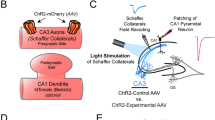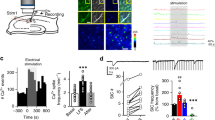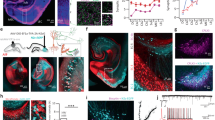Abstract
Postsynaptic spines at CA3-CA1 synapses differ in glutamate receptor composition according to the hemispheric origin of CA3 afferents. To study the functional consequences of this asymmetry, we used optogenetic tools to selectively stimulate axons of CA3 pyramidal cells originating in either left or right mouse hippocampus. We found that left CA3 input produced more long-term potentiation at CA1 synapses than right CA3 input as a result of differential expression of GluN2B subunit–containing NMDA receptors.
This is a preview of subscription content, access via your institution
Access options
Subscribe to this journal
Receive 12 print issues and online access
$209.00 per year
only $17.42 per issue
Buy this article
- Purchase on Springer Link
- Instant access to full article PDF
Prices may be subject to local taxes which are calculated during checkout



Similar content being viewed by others
Change history
13 October 2011
In the version of this article initially published, the schematics, traces and graphs in Figures. 2d and 2e were interchanged. The error has been corrected in the HTML and PDF versions of this article.
References
Toga, A.W. & Thompson, P.M. Nat. Rev. Neurosci. 4, 37–48 (2003).
Wu, Y. et al. J. Neurosci. 25, 9213–9226 (2005).
Shinohara, Y. et al. Proc. Natl. Acad. Sci. USA 105, 19498–19503 (2008).
Kawakami, R. et al. Science 300, 990–994 (2003).
Malinow, R. & Malenka, R.C. Annu. Rev. Neurosci. 25, 103–126 (2002).
Bliss, T.V. & Collingridge, G.L. Nature 361, 31–39 (1993).
Pike, F.G., Meredith, R.M., Olding, A.W. & Paulsen, O. J. Physiol. (Lond.) 518, 571–576 (1999).
Sohal, V.S., Zhang, F., Yizhar, O. & Deisseroth, K. Nature 459, 698–702 (2009).
Bliss, T.V.P., Lancaster, B. & Wheal, H.V. J. Physiol. (Lond.) 341, 617–626 (1983).
Wheal, H.V., Lancaster, B. & Bliss, T.V.P. Brain Res. 272, 247–253 (1983).
Barria, A. & Malinow, R. Neuron 48, 289–301 (2005).
Yashiro, K. & Philpot, B.D. Neuropharmacology 55, 1081–1094 (2008).
Hoffmann, H., Gremme, T., Hatt, H. & Gottman, K. J. Neurochem. 75, 1590–1599 (2000).
Mierau, S.B., Meredith, R.M., Upton, A.L. & Paulsen, O. Proc. Natl. Acad. Sci. USA 101, 15518–15523 (2004).
Aravanis, A.M. et al. J. Neural Eng. 4, S143–S156 (2007).
Acknowledgements
The authors would like to thank D. Paterson for providing surgery facilities, and D. Kätzel and L. Upton for help with immunohistochemistry. This research was supported by the Biotechnology and Biological Sciences Research Council and the Wellcome Trust (OXION Initiative). An equipment grant from the EPA Cephalosporin Fund is gratefully acknowledged.
Author information
Authors and Affiliations
Contributions
M.M.K. conducted the experiments and analyzed the data. O.A.S. contributed recordings. M.M.K. and R.M.D. injected the animals. J.N.P.R. provided advice on the project. K.D. designed and cloned the AAV DIO ChR2-YFP vector. M.M.K. and O.P. designed the experiments. M.M.K., O.A.S. and O.P. wrote the manuscript.
Corresponding author
Ethics declarations
Competing interests
The authors declare no competing financial interests.
Supplementary information
Supplementary Text and Figures
Supplementary Figures 1 and 2, Supplementary Table 1, and Supplementary Methods (PDF 546 kb)
Rights and permissions
About this article
Cite this article
Kohl, M., Shipton, O., Deacon, R. et al. Hemisphere-specific optogenetic stimulation reveals left-right asymmetry of hippocampal plasticity. Nat Neurosci 14, 1413–1415 (2011). https://doi.org/10.1038/nn.2915
Received:
Accepted:
Published:
Issue Date:
DOI: https://doi.org/10.1038/nn.2915
This article is cited by
-
Impaired functional connectivity of the hippocampus in translational murine models of NMDA-receptor antibody associated neuropsychiatric pathology
Molecular Psychiatry (2023)
-
Differential vulnerability of hippocampal CA3-CA1 synapses to Aβ
Acta Neuropathologica Communications (2022)
-
Multiomic profiling of the acute stress response in the mouse hippocampus
Nature Communications (2022)
-
Hemisphere-specific spatial representation by hippocampal granule cells
Nature Communications (2022)
-
Reflex memory theory of acquired involuntary motor and sensory disorders
The Egyptian Journal of Neurology, Psychiatry and Neurosurgery (2021)



